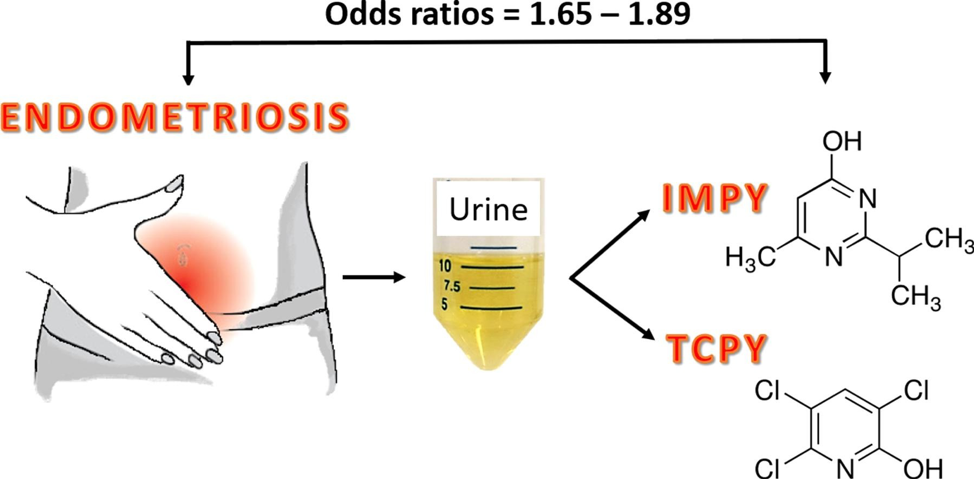15
Jan
Exploratory Study Indicates Pesticide Exposure May Relate to Higher Risk for Endometriosis

(Beyond Pesticides, January 15, 2019) A study published in the journal Environment International, Association of urinary metabolites of organophosphate and pyrethroid insecticides, and phenoxy herbicides with endometriosis, is the first of its kind. Researchers considered the endocrine-disrupting properties of pesticides (such as reduced sperm counts) and investigated whether there might be a relationship between pesticide exposure and endometriosis. Endometriosis is an estrogen-dependent gynecologic disease that affects about 176 million women globally. It can cause extreme pain and infertility as well as increased risk for cancer and cardiovascular diseases. This study finds a positive correlation between some pesticide metabolites and endometriosis, though authors encourage further study to corroborate the findings.
Researchers examined exposure to 11 “universal pesticides” and their metabolites and its relationship to endometriosis in 492 reproductive-age women recruited from 14 surgical centers in Utah and California from 2007-2009. The women at these clinics were scheduled for laparoscopy or laparotomy—the “gold standard” for identifying endometriosis is through these surgeries. The study compares results from the clinical cohort to a group of women in the same age bracket from areas surrounding the participating clinics. 619 urine samples were analyzed from the operative and population cohorts.
This study detected six of the pesticides or their metabolites in ≥95% of urine samples — including organophosphates and 2-4,D. Pyrethroids and their metabolites were detected in 47–80% of the samples. The odds ratios, or measure of association between exposure and an outcome, are significant for two organophosphate metabolites: 2-Isopropyl-4-methyl-6-hydroxypyrimidine (IMPY) and 3,5,6-trichloro-2-pyridinol (TCPY). The authors conclude, “Our results suggest that exposure to elevated concentrations of diazinon (the parent compound of IMPY) and chlorpyrifos and chlorpyrifos-methyl (parent compounds of TCPY) may be associated with endometriosis.” However, the authors emphasize the small sample size and need for further studies. “Our findings should be considered as exploratory,” they state.
Endocrine disrupting chemicals (EDCs) are far under-studied and under-regulated. In 2015, Beyond Pesticides summarized the Environmental Protection Agency’s performance on evaluating endocrine disrupting chemicals and protecting the public from them: “Delays and criticisms from scientists have highlighted inadequacies of the overall program. After FQPA [Food Quality Protection Act] set a 1999 deadline for EPA to develop a battery of assays with which pesticide manufacturers were required to screen their products as possible endocrine disruptors, EPA repeatedly pushed back the deadline for over a decade. Moreover, critics of EDSP have said that EPA’s testing protocol is outdated, failing to keep pace with the science.” Adding to the critique, in 2017 Beyond Pesticides covered the ongoing inadequacy of EPA’s progress on EDCs, noting that “inadequate federal testing, disproportionate industry influence, and subverted regulatory oversight threaten decades of progress on protecting people from hormone disrupting chemicals.”
As opposed to stalling and undermining the use of science in decision making, EPA must begin following a precautionary principle where they take measures to assess for harm before approval. The Precautionary Principle, as set out in 1998, says: “When an activity raises threats of harm to human health or the environment, precautionary measures should be taken even if some cause and effect relationships are not fully established scientifically. In this context the proponent of an activity, rather than the public, should bear the burden of proof. The process of applying the precautionary principle must be open, informed and democratic and must include potentially affected parties. It must also involve an examination of the full range of alternatives, including no action.”
It is a fact that our nation and world are saturated with human-made chemicals — 80,000 on the market in the U.S. alone, and most synthesized only in the past 50 years. The majority of those compounds have not been evaluated for effects other than acute toxicity, and 95% have not been reviewed for potential impacts on children. Given these circumstances, Beyond Pesticides advocates for a Precautionary approach to permitting of all pesticides, and for the transition to a world free of them. Join us: https://beyondpesticides.org/join/sign-me-up.
All unattributed positions and opinions in this piece are those of Beyond Pesticides.
Source: Environment International










